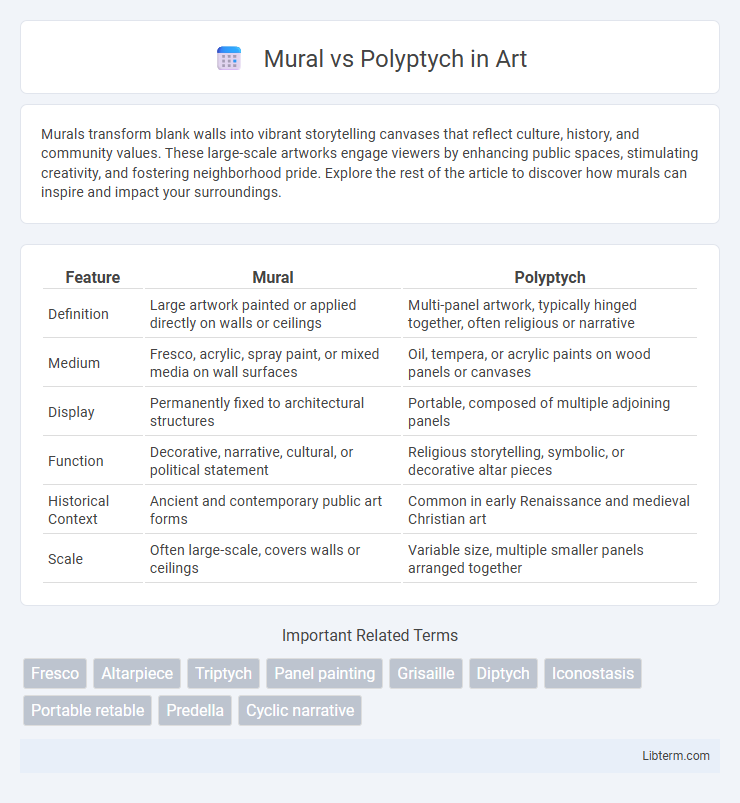Murals transform blank walls into vibrant storytelling canvases that reflect culture, history, and community values. These large-scale artworks engage viewers by enhancing public spaces, stimulating creativity, and fostering neighborhood pride. Explore the rest of the article to discover how murals can inspire and impact your surroundings.
Table of Comparison
| Feature | Mural | Polyptych |
|---|---|---|
| Definition | Large artwork painted or applied directly on walls or ceilings | Multi-panel artwork, typically hinged together, often religious or narrative |
| Medium | Fresco, acrylic, spray paint, or mixed media on wall surfaces | Oil, tempera, or acrylic paints on wood panels or canvases |
| Display | Permanently fixed to architectural structures | Portable, composed of multiple adjoining panels |
| Function | Decorative, narrative, cultural, or political statement | Religious storytelling, symbolic, or decorative altar pieces |
| Historical Context | Ancient and contemporary public art forms | Common in early Renaissance and medieval Christian art |
| Scale | Often large-scale, covers walls or ceilings | Variable size, multiple smaller panels arranged together |
Introduction to Murals and Polyptychs
Murals are large-scale artworks painted or applied directly onto walls, ceilings, or other permanent surfaces, often used to convey social, cultural, or historical narratives in public spaces. Polyptychs consist of multiple connected panels, usually hinged, forming a cohesive visual story or religious scene, prominently featured in medieval and Renaissance altarpieces. Both art forms emphasize storytelling through visual means, but murals integrate with architectural space while polyptychs remain distinct, transportable objects.
Defining Murals: History and Characteristics
Murals are large-scale artworks painted or applied directly onto walls, ceilings, or other permanent surfaces, often serving as public or communal expressions throughout history. Originating from ancient civilizations like the Egyptians and Greeks, murals typically depict historic, cultural, or religious themes with a focus on narrative and visual impact in public spaces. Their characteristics include expansive size, integration with architecture, and use of durable materials such as fresco, acrylic, or mosaic to withstand environmental conditions.
Understanding Polyptychs: Origins and Forms
Polyptychs originated in medieval and Renaissance art as multi-paneled altarpieces designed to depict religious narratives in segmented but interconnected scenes. These works typically consist of three or more panels hinged together, allowing them to be folded or displayed in various configurations, often featuring a central panel flanked by smaller wings. Understanding polyptychs involves recognizing their function as complex storytelling devices that combine visual symmetry with thematic unity, distinguishing them from single, large-scale murals.
Artistic Techniques: Mural vs Polyptych
Mural techniques involve painting directly onto large architectural surfaces, using fresco or secco methods to integrate art seamlessly with the environment, emphasizing scale and permanence. Polyptych art consists of multiple interconnected panels, often hinged, allowing artists to explore narrative complexity and varied perspectives across distinct but related images. The mural's continuous composition contrasts with the polyptych's segmented format, highlighting different approaches to storytelling and spatial interaction in visual art.
Context and Placement: Walls vs Panels
Murals are large-scale artworks directly painted or applied onto walls, transforming architectural spaces into immersive visual experiences that engage viewers within a specific environment. Polyptychs consist of multiple hinged panels, often used in altarpieces or portable displays, allowing flexible placement and interaction in galleries or private settings. Walls provide a permanent, expansive canvas influencing spatial perception, while panels offer modularity and portability for curated or changing contexts.
Materials Used in Murals and Polyptychs
Murals are typically created directly on walls using materials such as lime plaster, acrylic paints, and fresco techniques that involve applying pigments to wet plaster for durability. Polyptychs consist of multiple painted panels, often crafted on wood, canvas, or metal surfaces using oil or tempera paints that allow intricate detailing and portability. The choice of materials in murals emphasizes permanence and integration with architecture, while polyptychs prioritize panel construction and detailed panel-to-panel continuity.
Narrative Approaches: Continuous Storytelling vs Segmented Scenes
Mural art employs continuous storytelling through expansive, interconnected compositions that guide viewers along a seamless narrative path, immersing them in a unified visual experience. Polyptychs utilize segmented scenes divided into discrete panels, each depicting distinct moments or episodes, encouraging focused interpretation of individual narrative elements. These differing approaches influence how audiences perceive and engage with the story, either as an uninterrupted flow or as separate, thematically linked vignettes.
Iconography and Symbolism Comparison
Murals often employ large-scale iconography that integrates religious and cultural symbolism, using vivid imagery to convey collective narratives and communal values. Polyptychs, typically multi-paneled altarpieces, focus on detailed symbolic representations within each panel, allowing for intricate theological storytelling and hierarchical importance of saints or biblical scenes. Both art forms utilize iconography to enhance spiritual engagement but differ in format and visual complexity, with murals emphasizing overarching themes and polyptychs providing segmented, narrative depth.
Notable Examples in Art History
Mural art is famously exemplified by Diego Rivera's Detroit Industry Murals, showcasing large-scale public storytelling through rich fresco techniques. Polyptychs, such as the Ghent Altarpiece by Jan van Eyck, demonstrate intricate panel compositions that convey complex religious narratives. These masterpieces highlight the distinct approaches of murals as expansive wall paintings and polyptychs as multi-paneled altarpieces in art history.
Choosing Between Mural and Polyptych for Your Space
Choosing between a mural and a polyptych depends on the spatial dynamics and aesthetic goals of your environment. Murals offer expansive, immersive visuals ideal for large, uninterrupted walls, while polyptychs provide segmented yet cohesive art suitable for adaptable layouts and modular presentations. Consider the scale, wall texture, and natural lighting to optimize the visual impact and harmony within your specific space.
Mural Infographic

 libterm.com
libterm.com